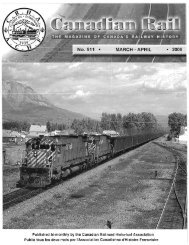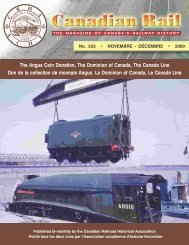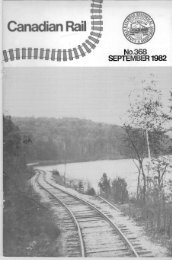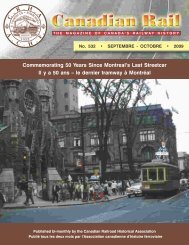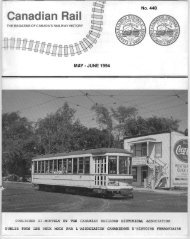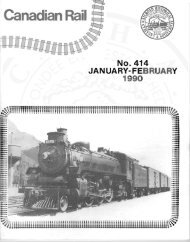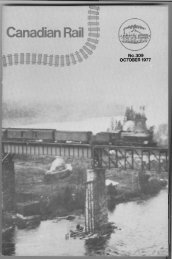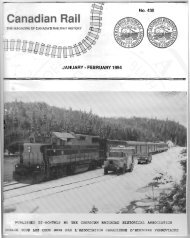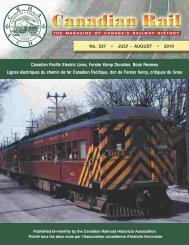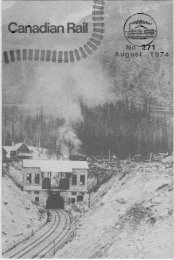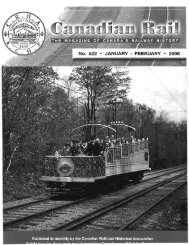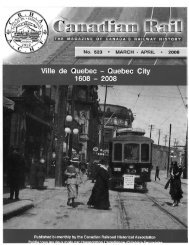Canadian Rail_no539_2010 - Le musée ferroviaire canadien
Canadian Rail_no539_2010 - Le musée ferroviaire canadien
Canadian Rail_no539_2010 - Le musée ferroviaire canadien
Create successful ePaper yourself
Turn your PDF publications into a flip-book with our unique Google optimized e-Paper software.
RAIL CANADIEN • 539 261<br />
NOVEMBRE – DÉCEMBRE <strong>2010</strong><br />
<strong>Le</strong>ft to right: Head-end<br />
brakeman Al Peden,<br />
conductor George Ellis<br />
and fireman Ralph Grant<br />
at Portage Junction<br />
waiting to go on the<br />
Miami wayfreight, August<br />
3, 1951.<br />
De gauche à droite : le<br />
serre-frein, Al Peden, le<br />
chef de train George Ellis<br />
et le chauffeur Ralph<br />
Grant à Portage Junction<br />
attendent le départ de ce<br />
train de marchandises<br />
vers Miami en ce 3 août<br />
1951.<br />
In the middle of July 1951 the <strong>Canadian</strong> National<br />
<strong>Rail</strong>ways began hiring brakemen again. My brother, Bill,<br />
was a good friend of Don Mc<strong>Le</strong>nnan, secretary for A.C.<br />
Nicols, Superintendent of the subdivision encompassing<br />
the Portage-Brandon area. Bill spoke to Don about<br />
getting me on as a brakeman. A few days later, I was hired<br />
and had commenced making three student trips. It was<br />
necessary to make these three student trips before I could<br />
make my first pay trip and establish myself with a seniority<br />
number. Don advised me to make these trips as quickly as<br />
possible because my seniority didn’t begin until they were<br />
completed.<br />
Having completed the required three student<br />
trips, my name was placed on the "spare board" in the Fort<br />
Rouge yard office in Winnipeg, right behind Neil Sorby<br />
who completed his third student trip a few hours ahead of<br />
me. My official "seniority date" was established as July 18,<br />
1951 and my seniority number as a Freight Trainman in<br />
the Manitoba District was 74, one turn behind Sorby.<br />
Anybody, who hired on as a brakeman in this region after<br />
that date was junior to me and when the spare board was<br />
cut, would be laid-off ahead of me. Similarly, if a job were<br />
posted and I bid on it, I would get the job if no one with<br />
more seniority than myself bid on it. As things turned out,<br />
I didn’t have to worry about bidding on many jobs. With<br />
steam power soon to be replaced by much more powerful<br />
diesel units, it was a struggle just to keep from being laidoff.<br />
In July of 1951, the Fort Rouge terminal was<br />
booming as it usually did at that time of the year as grain<br />
from Manitoba and Saskatchewan was moving eastwards<br />
to the Lakehead elevators where it was then loaded onto<br />
boats for shipment to points all over the world. The<br />
Transcona terminal on the CNR main line was equally<br />
busy hauling all the commodities of a bustling economy –<br />
lumber, autos, chemicals, grain and manufactured goods<br />
of every description. Crews were working as hard as they<br />
could go; booking only a few hours rest at the home<br />
terminal and doubling right back from the other end.<br />
Steam power was at its zenith in that hot summer and<br />
every engine that could make steam, from the tired old<br />
1300 hand fired engines to the 3500 and 4000 class<br />
workhorses were pushed to the limit.<br />
It’s still hard to believe that only a few years later<br />
they would all be cut up for scrap; even the beautiful sleek<br />
6000 class passenger engines with 6 foot drivers --- gone.<br />
What mindless railway official would give the OK to put<br />
to the cutter’s torch the heritage of a nation for the few<br />
paltry dollars they were worth in scrap value? Today, the<br />
country is left with very few steam locomotives on display<br />
and most of the beautiful 6000 and 6200 class passenger<br />
engines were put to the torch. Many more should have<br />
been preserved for future generations across the country<br />
to observe and admire.<br />
Two views of <strong>Canadian</strong> National <strong>Rail</strong>ways Class T-1-c 2-10-2 4030, a 1920 product of Montreal Locomotive Works being serviced<br />
at Manaki, Ontario in the 1930s. All of this typical small town servicing infrastructure would be eliminated with the advent of diesels!<br />
Al Paterson.<br />
La no 4030 avec une grue puis avec quelques hommes circulant autour. Deux vues de cette locomotive du Canadien National<br />
2-10-2 de classe T-1-c, construite en 1920 par la Montreal Locomotive Works, fait le plein à Manaki en Ontario dans les années<br />
1930. Ce centre de service typique d’une petite localité sera éliminé avec la venue du diesel! Al Paterson.



